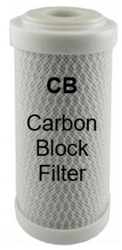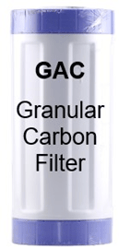Can Activated Carbon Filters Remove Iron?
Can Activated Carbon Filters Remove Iron?
Activated carbon filters are best at removing chlorine and bad tastes or odors but may be certified to remove other contaminants such as iron. Iron can contribute an unpleasant metallic taste to water and food. You will find conflicting information on whether or not activated carbon can remove iron.
There are claims made that activated carbon is effective at removing iron. Look for the NSF certification on a carbon filter to find out exactly what it is capable of removing. If it is certified to remove iron, then yes it will remove iron. How much iron it will remove becomes the question.
The Boshart 14-CB1-05,10, 14CB2-05, 10, 14-GCB1-10 & 14-GCB2-10 carbon block filters are 5 and 10 micron and are not certified to remove iron.
There are two basic types of activated carbon filters:
 1) Carbon Block Filters
1) Carbon Block Filters
A variety of contaminants can be effectively reduced or removed by carbon block filters, including VOCs, THMs, mercury, chlorine, and more. A carbon block filter's ability to remove contaminants depends upon the filter micron rating.
Some carbon block filters rated at one micron or less (meaning they have a very small pore size) are certified to remove lead, iron, arsenic, cysts, and coliform bacteria.
IMPORTANT: Elevated levels of iron 10, 15, 29, 30+ ppm must be evaluated and treated on an individual basis, and you will need to invest in a water treatment system specifically designed to remove larger volumes of iron. Contact your local water treatment specialist for more information.
 2) GAC Filters
2) GAC Filters
Granular Activated Carbon or "GAC" filters are often used as "polishing filters" in the RO (Reverse Osmosis) process. GAC filters can remove VOCs, pesticides, hydrogen sulfide, and much more. GAC filters also can be used to remove chemicals that give objectionable odors or tastes to water such as hydrogen sulfide (rotten eggs odor) or chlorine.
However, iron and nitrates are not attracted to the carbon and are not removed. Another type of filter, such as reverse osmosis (RO) or green sand may be needed.
Iron Removal Systems
Iron removal systems come in several types. It is not a simple case of one type fits each situation. We suggest you start by obtaining a well-detailed water analysis from an independent lab. Then you should consult a water treatment specialist for the right solution for you. They will have an understanding of what levels of iron and other contaminants are in your water. Depending on what other contaminants are found in your water, it may change the type of treatment system(s) you need. Below is a list of 10 iron removal systems.
- Water Softeners
- Oxidation Iron Removal Systems
- Chlorine Based Iron Removal Systems
- Potassium Permanganate Based Iron Removal Systems
- Aeration Based Iron Removal Systems
- Ozone Based Iron Removal Systems
- Continuous Regeneration Greensand Iron Removal Systems
- Pyrolox, Filox & Katalox Light Based Iron Removal Systems
- Polyphosphate Sequestering Based Iron Removal Systems
- Hydrogen Peroxide Based Iron Removal Systems
